CHC30113 Certificate III Early Childhood Education Assessment Workbook
VerifiedAdded on 2022/05/25
|69
|14404
|18
Homework Assignment
AI Summary
This assessment workbook, designed for the CHC30113 Certificate III in Early Childhood Education and Care, covers key aspects of early childhood development and care. It includes detailed instructions on competency-based assessment, principles of assessment, and the rules of evidence. The workbook is divided into several parts, each focusing on different units of competency such as supporting holistic development, using information about children to inform practice, and supporting the behaviour of children and young people. It outlines performance and knowledge evidence required for each unit, along with case studies and a project to assess practical application of the concepts. The assessment covers topics like child development, observation techniques, program planning, and positive behaviour support strategies, all essential for early childhood educators. The workbook also provides information on the National Quality Framework, the National Quality Standards, and the relevant approved learning framework. It includes various assessment methods, such as knowledge assessments, case studies, and a project, to ensure a comprehensive evaluation of the candidate's skills and knowledge.
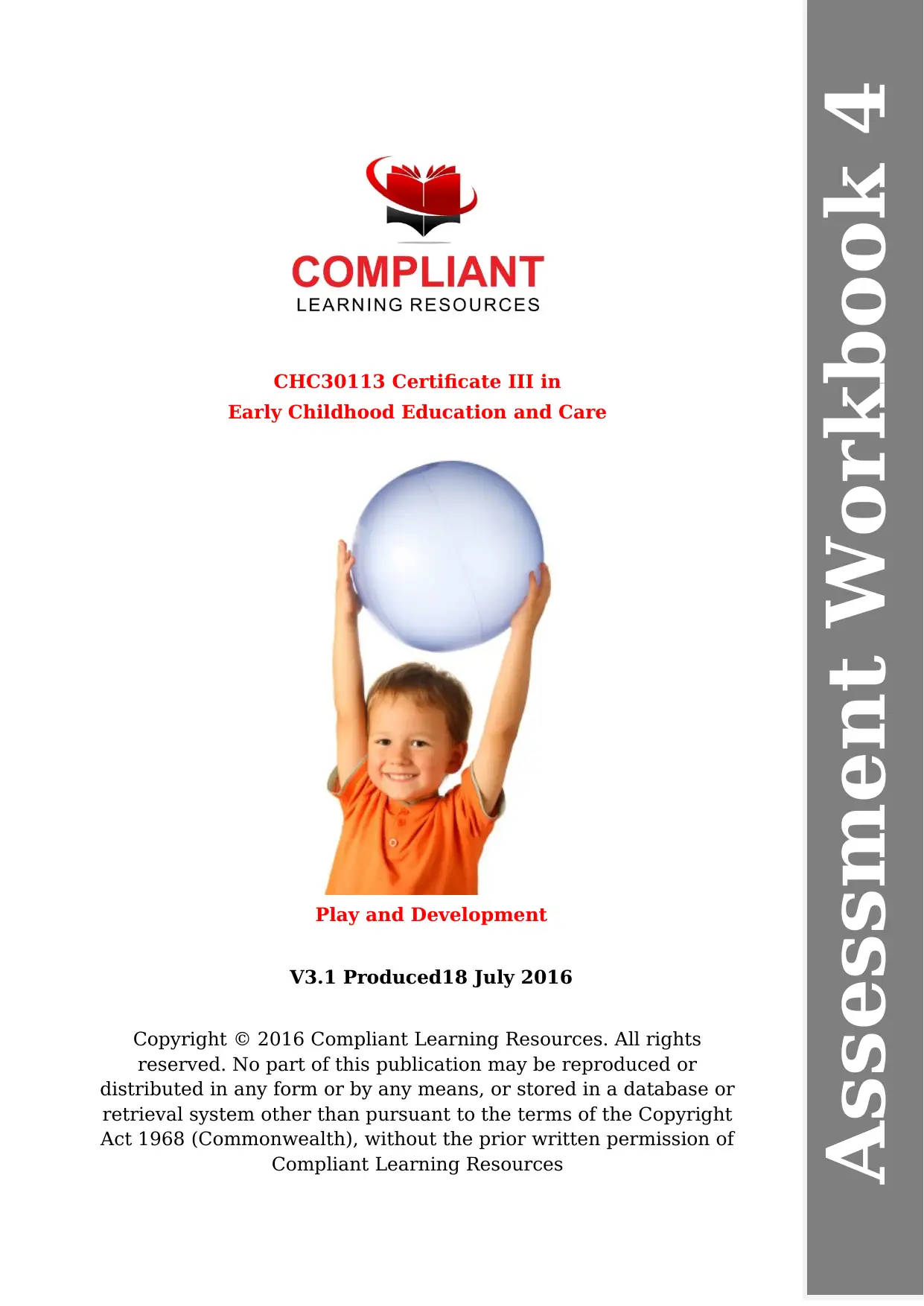
CHC30113 Certificate III in
Early Childhood Education and Care
Play and Development
V3.1 Produced18 July 2016
Copyright © 2016 Compliant Learning Resources. All rights
reserved. No part of this publication may be reproduced or
distributed in any form or by any means, or stored in a database or
retrieval system other than pursuant to the terms of the Copyright
Act 1968 (Commonwealth), without the prior written permission of
Compliant Learning Resources
Assessment Workbook 4
Early Childhood Education and Care
Play and Development
V3.1 Produced18 July 2016
Copyright © 2016 Compliant Learning Resources. All rights
reserved. No part of this publication may be reproduced or
distributed in any form or by any means, or stored in a database or
retrieval system other than pursuant to the terms of the Copyright
Act 1968 (Commonwealth), without the prior written permission of
Compliant Learning Resources
Assessment Workbook 4
Paraphrase This Document
Need a fresh take? Get an instant paraphrase of this document with our AI Paraphraser
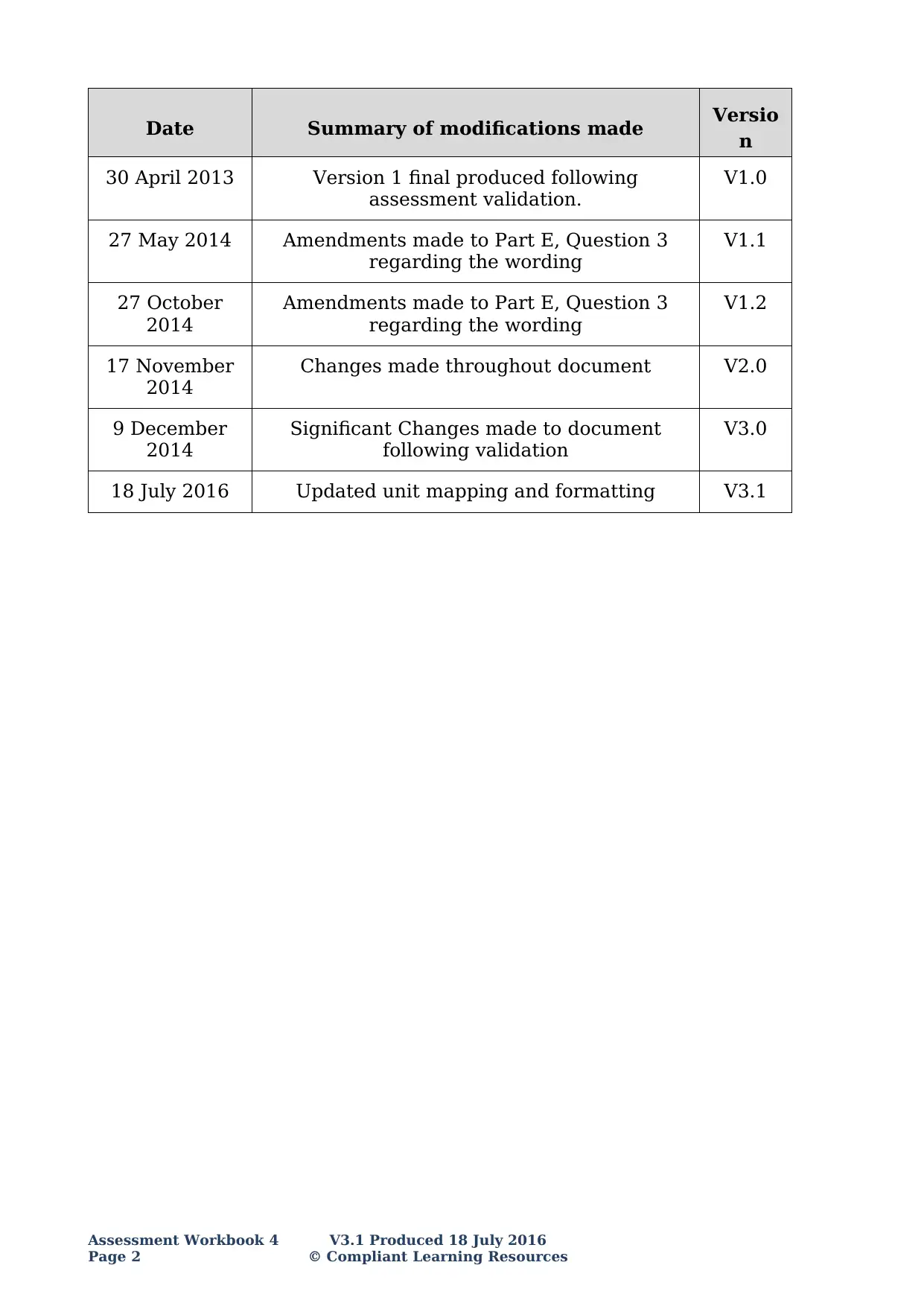
Date Summary of modifications made Versio
n
30 April 2013 Version 1 final produced following
assessment validation.
V1.0
27 May 2014 Amendments made to Part E, Question 3
regarding the wording
V1.1
27 October
2014
Amendments made to Part E, Question 3
regarding the wording
V1.2
17 November
2014
Changes made throughout document V2.0
9 December
2014
Significant Changes made to document
following validation
V3.0
18 July 2016 Updated unit mapping and formatting V3.1
Assessment Workbook 4 V3.1 Produced 18 July 2016
Page 2 © Compliant Learning Resources
n
30 April 2013 Version 1 final produced following
assessment validation.
V1.0
27 May 2014 Amendments made to Part E, Question 3
regarding the wording
V1.1
27 October
2014
Amendments made to Part E, Question 3
regarding the wording
V1.2
17 November
2014
Changes made throughout document V2.0
9 December
2014
Significant Changes made to document
following validation
V3.0
18 July 2016 Updated unit mapping and formatting V3.1
Assessment Workbook 4 V3.1 Produced 18 July 2016
Page 2 © Compliant Learning Resources
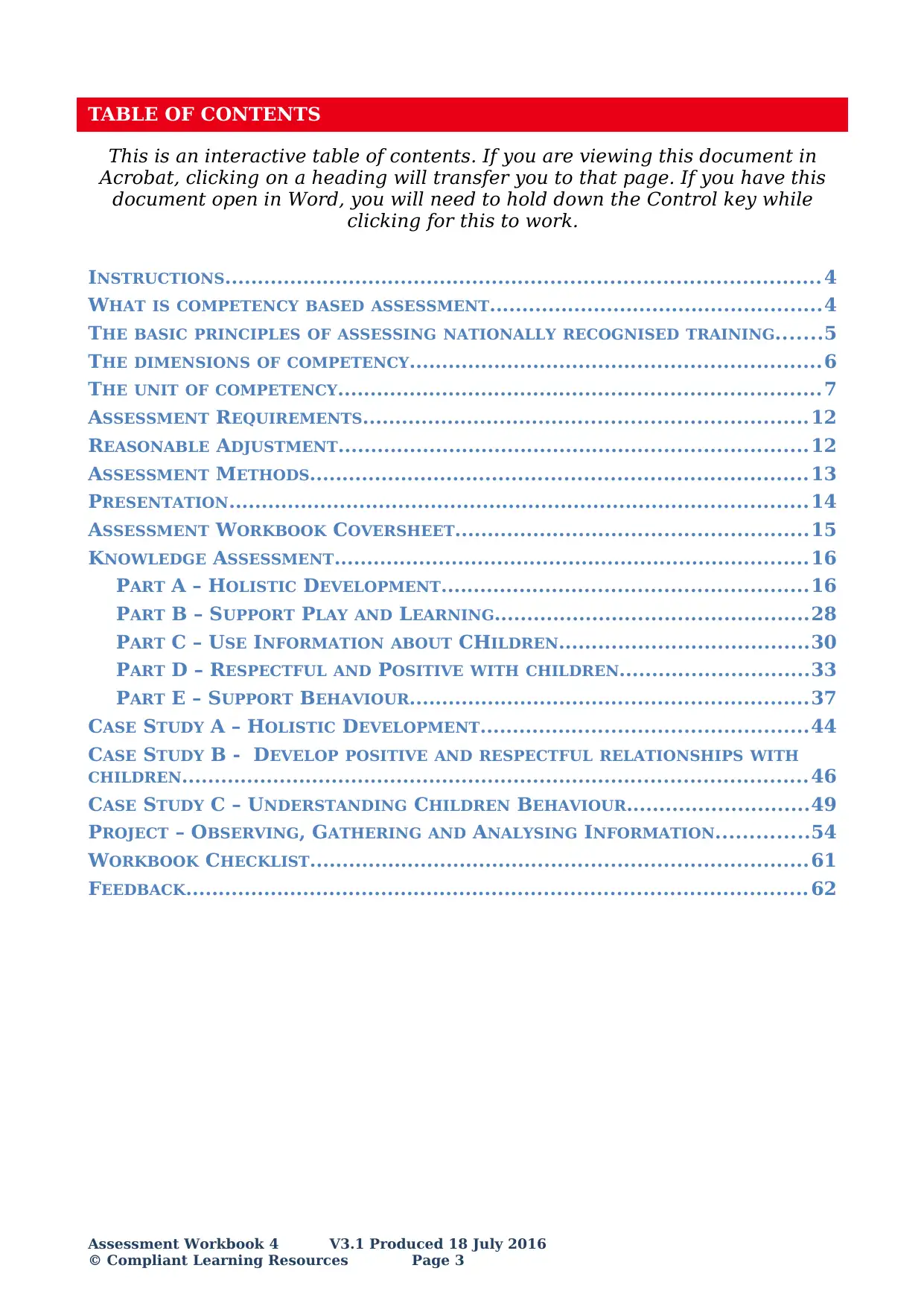
TABLE OF CONTENTS
This is an interactive table of contents. If you are viewing this document in
Acrobat, clicking on a heading will transfer you to that page. If you have this
document open in Word, you will need to hold down the Control key while
clicking for this to work.
INSTRUCTIONS........................................................................................... 4
WHAT IS COMPETENCY BASED ASSESSMENT...................................................4
THE BASIC PRINCIPLES OF ASSESSING NATIONALLY RECOGNISED TRAINING.......5
THE DIMENSIONS OF COMPETENCY...............................................................6
THE UNIT OF COMPETENCY..........................................................................7
ASSESSMENT REQUIREMENTS....................................................................12
REASONABLE ADJUSTMENT........................................................................12
ASSESSMENT METHODS............................................................................13
PRESENTATION.........................................................................................14
ASSESSMENT WORKBOOK COVERSHEET......................................................15
KNOWLEDGE ASSESSMENT.........................................................................16
PART A – HOLISTIC DEVELOPMENT........................................................16
PART B – SUPPORT PLAY AND LEARNING................................................28
PART C – USE INFORMATION ABOUT CHILDREN......................................30
PART D – RESPECTFUL AND POSITIVE WITH CHILDREN.............................33
PART E – SUPPORT BEHAVIOUR.............................................................37
CASE STUDY A – HOLISTIC DEVELOPMENT..................................................44
CASE STUDY B - DEVELOP POSITIVE AND RESPECTFUL RELATIONSHIPS WITH
CHILDREN................................................................................................ 46
CASE STUDY C – UNDERSTANDING CHILDREN BEHAVIOUR............................49
PROJECT – OBSERVING, GATHERING AND ANALYSING INFORMATION..............54
WORKBOOK CHECKLIST............................................................................61
FEEDBACK............................................................................................... 62
Assessment Workbook 4 V3.1 Produced 18 July 2016
© Compliant Learning Resources Page 3
This is an interactive table of contents. If you are viewing this document in
Acrobat, clicking on a heading will transfer you to that page. If you have this
document open in Word, you will need to hold down the Control key while
clicking for this to work.
INSTRUCTIONS........................................................................................... 4
WHAT IS COMPETENCY BASED ASSESSMENT...................................................4
THE BASIC PRINCIPLES OF ASSESSING NATIONALLY RECOGNISED TRAINING.......5
THE DIMENSIONS OF COMPETENCY...............................................................6
THE UNIT OF COMPETENCY..........................................................................7
ASSESSMENT REQUIREMENTS....................................................................12
REASONABLE ADJUSTMENT........................................................................12
ASSESSMENT METHODS............................................................................13
PRESENTATION.........................................................................................14
ASSESSMENT WORKBOOK COVERSHEET......................................................15
KNOWLEDGE ASSESSMENT.........................................................................16
PART A – HOLISTIC DEVELOPMENT........................................................16
PART B – SUPPORT PLAY AND LEARNING................................................28
PART C – USE INFORMATION ABOUT CHILDREN......................................30
PART D – RESPECTFUL AND POSITIVE WITH CHILDREN.............................33
PART E – SUPPORT BEHAVIOUR.............................................................37
CASE STUDY A – HOLISTIC DEVELOPMENT..................................................44
CASE STUDY B - DEVELOP POSITIVE AND RESPECTFUL RELATIONSHIPS WITH
CHILDREN................................................................................................ 46
CASE STUDY C – UNDERSTANDING CHILDREN BEHAVIOUR............................49
PROJECT – OBSERVING, GATHERING AND ANALYSING INFORMATION..............54
WORKBOOK CHECKLIST............................................................................61
FEEDBACK............................................................................................... 62
Assessment Workbook 4 V3.1 Produced 18 July 2016
© Compliant Learning Resources Page 3
⊘ This is a preview!⊘
Do you want full access?
Subscribe today to unlock all pages.

Trusted by 1+ million students worldwide
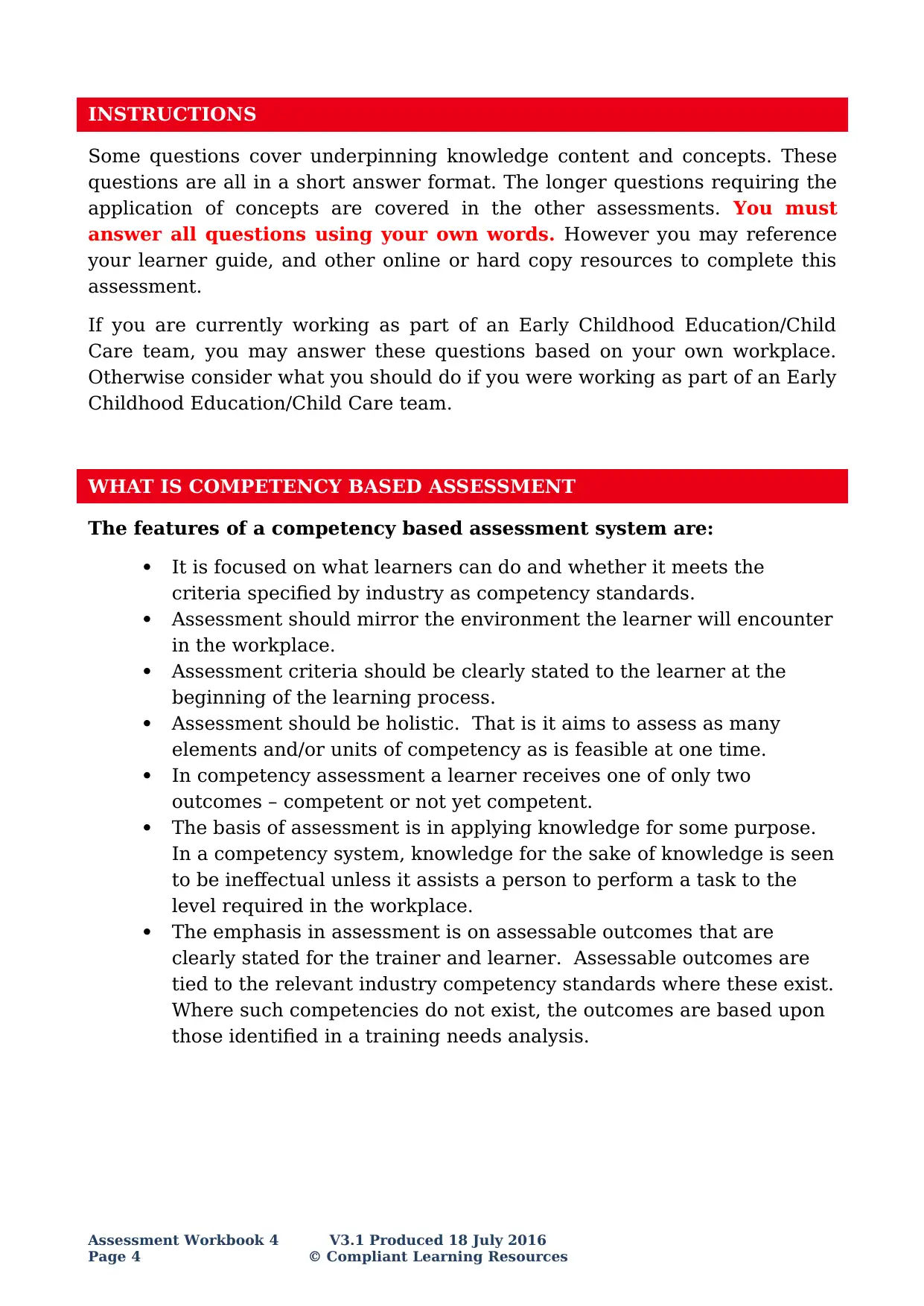
INSTRUCTIONS
Some questions cover underpinning knowledge content and concepts. These
questions are all in a short answer format. The longer questions requiring the
application of concepts are covered in the other assessments. You must
answer all questions using your own words. However you may reference
your learner guide, and other online or hard copy resources to complete this
assessment.
If you are currently working as part of an Early Childhood Education/Child
Care team, you may answer these questions based on your own workplace.
Otherwise consider what you should do if you were working as part of an Early
Childhood Education/Child Care team.
WHAT IS COMPETENCY BASED ASSESSMENT
The features of a competency based assessment system are:
It is focused on what learners can do and whether it meets the
criteria specified by industry as competency standards.
Assessment should mirror the environment the learner will encounter
in the workplace.
Assessment criteria should be clearly stated to the learner at the
beginning of the learning process.
Assessment should be holistic. That is it aims to assess as many
elements and/or units of competency as is feasible at one time.
In competency assessment a learner receives one of only two
outcomes – competent or not yet competent.
The basis of assessment is in applying knowledge for some purpose.
In a competency system, knowledge for the sake of knowledge is seen
to be ineffectual unless it assists a person to perform a task to the
level required in the workplace.
The emphasis in assessment is on assessable outcomes that are
clearly stated for the trainer and learner. Assessable outcomes are
tied to the relevant industry competency standards where these exist.
Where such competencies do not exist, the outcomes are based upon
those identified in a training needs analysis.
Assessment Workbook 4 V3.1 Produced 18 July 2016
Page 4 © Compliant Learning Resources
Some questions cover underpinning knowledge content and concepts. These
questions are all in a short answer format. The longer questions requiring the
application of concepts are covered in the other assessments. You must
answer all questions using your own words. However you may reference
your learner guide, and other online or hard copy resources to complete this
assessment.
If you are currently working as part of an Early Childhood Education/Child
Care team, you may answer these questions based on your own workplace.
Otherwise consider what you should do if you were working as part of an Early
Childhood Education/Child Care team.
WHAT IS COMPETENCY BASED ASSESSMENT
The features of a competency based assessment system are:
It is focused on what learners can do and whether it meets the
criteria specified by industry as competency standards.
Assessment should mirror the environment the learner will encounter
in the workplace.
Assessment criteria should be clearly stated to the learner at the
beginning of the learning process.
Assessment should be holistic. That is it aims to assess as many
elements and/or units of competency as is feasible at one time.
In competency assessment a learner receives one of only two
outcomes – competent or not yet competent.
The basis of assessment is in applying knowledge for some purpose.
In a competency system, knowledge for the sake of knowledge is seen
to be ineffectual unless it assists a person to perform a task to the
level required in the workplace.
The emphasis in assessment is on assessable outcomes that are
clearly stated for the trainer and learner. Assessable outcomes are
tied to the relevant industry competency standards where these exist.
Where such competencies do not exist, the outcomes are based upon
those identified in a training needs analysis.
Assessment Workbook 4 V3.1 Produced 18 July 2016
Page 4 © Compliant Learning Resources
Paraphrase This Document
Need a fresh take? Get an instant paraphrase of this document with our AI Paraphraser
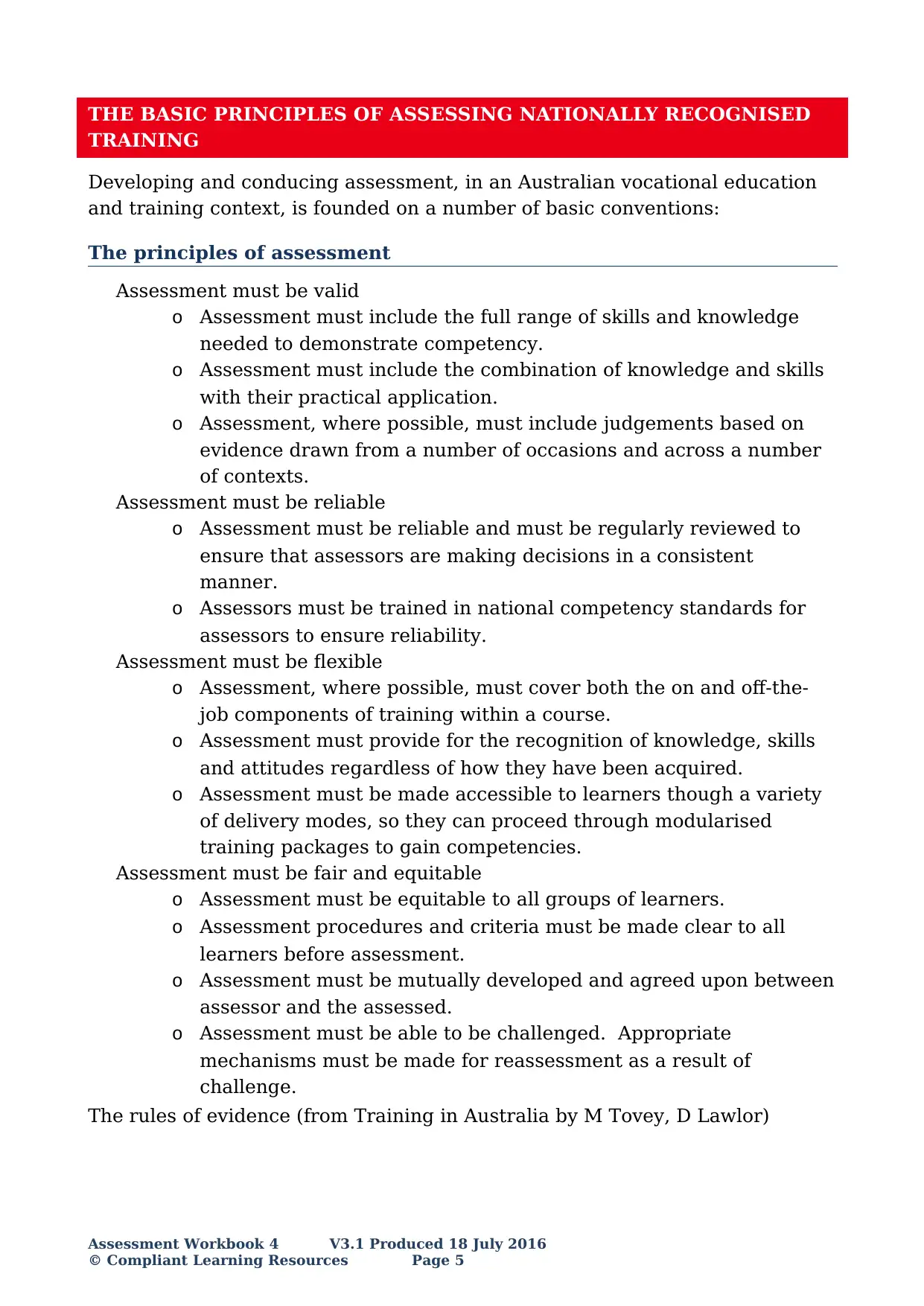
THE BASIC PRINCIPLES OF ASSESSING NATIONALLY RECOGNISED
TRAINING
Developing and conducing assessment, in an Australian vocational education
and training context, is founded on a number of basic conventions:
The principles of assessment
Assessment must be valid
o Assessment must include the full range of skills and knowledge
needed to demonstrate competency.
o Assessment must include the combination of knowledge and skills
with their practical application.
o Assessment, where possible, must include judgements based on
evidence drawn from a number of occasions and across a number
of contexts.
Assessment must be reliable
o Assessment must be reliable and must be regularly reviewed to
ensure that assessors are making decisions in a consistent
manner.
o Assessors must be trained in national competency standards for
assessors to ensure reliability.
Assessment must be flexible
o Assessment, where possible, must cover both the on and off-the-
job components of training within a course.
o Assessment must provide for the recognition of knowledge, skills
and attitudes regardless of how they have been acquired.
o Assessment must be made accessible to learners though a variety
of delivery modes, so they can proceed through modularised
training packages to gain competencies.
Assessment must be fair and equitable
o Assessment must be equitable to all groups of learners.
o Assessment procedures and criteria must be made clear to all
learners before assessment.
o Assessment must be mutually developed and agreed upon between
assessor and the assessed.
o Assessment must be able to be challenged. Appropriate
mechanisms must be made for reassessment as a result of
challenge.
The rules of evidence (from Training in Australia by M Tovey, D Lawlor)
Assessment Workbook 4 V3.1 Produced 18 July 2016
© Compliant Learning Resources Page 5
TRAINING
Developing and conducing assessment, in an Australian vocational education
and training context, is founded on a number of basic conventions:
The principles of assessment
Assessment must be valid
o Assessment must include the full range of skills and knowledge
needed to demonstrate competency.
o Assessment must include the combination of knowledge and skills
with their practical application.
o Assessment, where possible, must include judgements based on
evidence drawn from a number of occasions and across a number
of contexts.
Assessment must be reliable
o Assessment must be reliable and must be regularly reviewed to
ensure that assessors are making decisions in a consistent
manner.
o Assessors must be trained in national competency standards for
assessors to ensure reliability.
Assessment must be flexible
o Assessment, where possible, must cover both the on and off-the-
job components of training within a course.
o Assessment must provide for the recognition of knowledge, skills
and attitudes regardless of how they have been acquired.
o Assessment must be made accessible to learners though a variety
of delivery modes, so they can proceed through modularised
training packages to gain competencies.
Assessment must be fair and equitable
o Assessment must be equitable to all groups of learners.
o Assessment procedures and criteria must be made clear to all
learners before assessment.
o Assessment must be mutually developed and agreed upon between
assessor and the assessed.
o Assessment must be able to be challenged. Appropriate
mechanisms must be made for reassessment as a result of
challenge.
The rules of evidence (from Training in Australia by M Tovey, D Lawlor)
Assessment Workbook 4 V3.1 Produced 18 July 2016
© Compliant Learning Resources Page 5
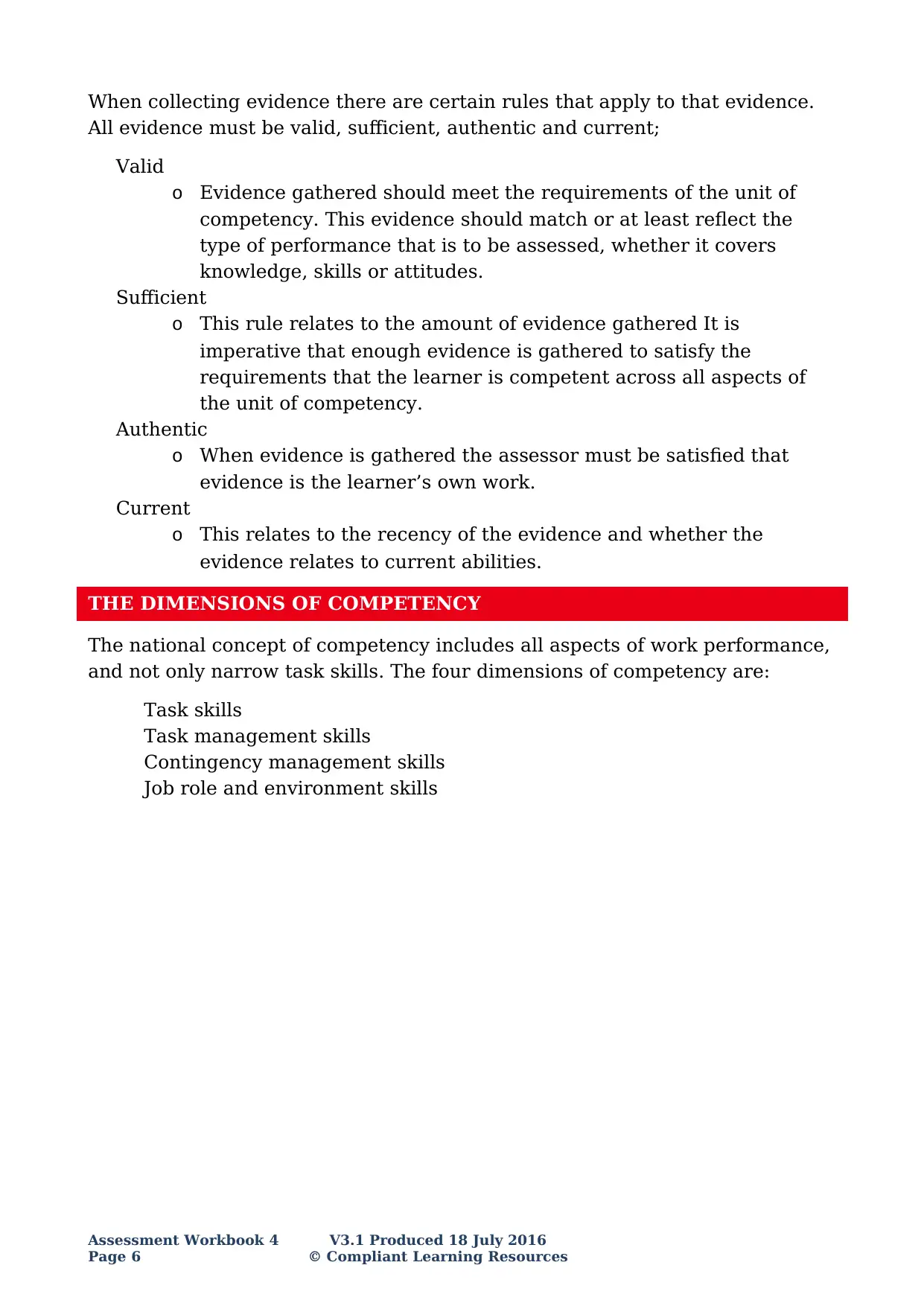
When collecting evidence there are certain rules that apply to that evidence.
All evidence must be valid, sufficient, authentic and current;
Valid
o Evidence gathered should meet the requirements of the unit of
competency. This evidence should match or at least reflect the
type of performance that is to be assessed, whether it covers
knowledge, skills or attitudes.
Sufficient
o This rule relates to the amount of evidence gathered It is
imperative that enough evidence is gathered to satisfy the
requirements that the learner is competent across all aspects of
the unit of competency.
Authentic
o When evidence is gathered the assessor must be satisfied that
evidence is the learner’s own work.
Current
o This relates to the recency of the evidence and whether the
evidence relates to current abilities.
THE DIMENSIONS OF COMPETENCY
The national concept of competency includes all aspects of work performance,
and not only narrow task skills. The four dimensions of competency are:
Task skills
Task management skills
Contingency management skills
Job role and environment skills
Assessment Workbook 4 V3.1 Produced 18 July 2016
Page 6 © Compliant Learning Resources
All evidence must be valid, sufficient, authentic and current;
Valid
o Evidence gathered should meet the requirements of the unit of
competency. This evidence should match or at least reflect the
type of performance that is to be assessed, whether it covers
knowledge, skills or attitudes.
Sufficient
o This rule relates to the amount of evidence gathered It is
imperative that enough evidence is gathered to satisfy the
requirements that the learner is competent across all aspects of
the unit of competency.
Authentic
o When evidence is gathered the assessor must be satisfied that
evidence is the learner’s own work.
Current
o This relates to the recency of the evidence and whether the
evidence relates to current abilities.
THE DIMENSIONS OF COMPETENCY
The national concept of competency includes all aspects of work performance,
and not only narrow task skills. The four dimensions of competency are:
Task skills
Task management skills
Contingency management skills
Job role and environment skills
Assessment Workbook 4 V3.1 Produced 18 July 2016
Page 6 © Compliant Learning Resources
⊘ This is a preview!⊘
Do you want full access?
Subscribe today to unlock all pages.

Trusted by 1+ million students worldwide
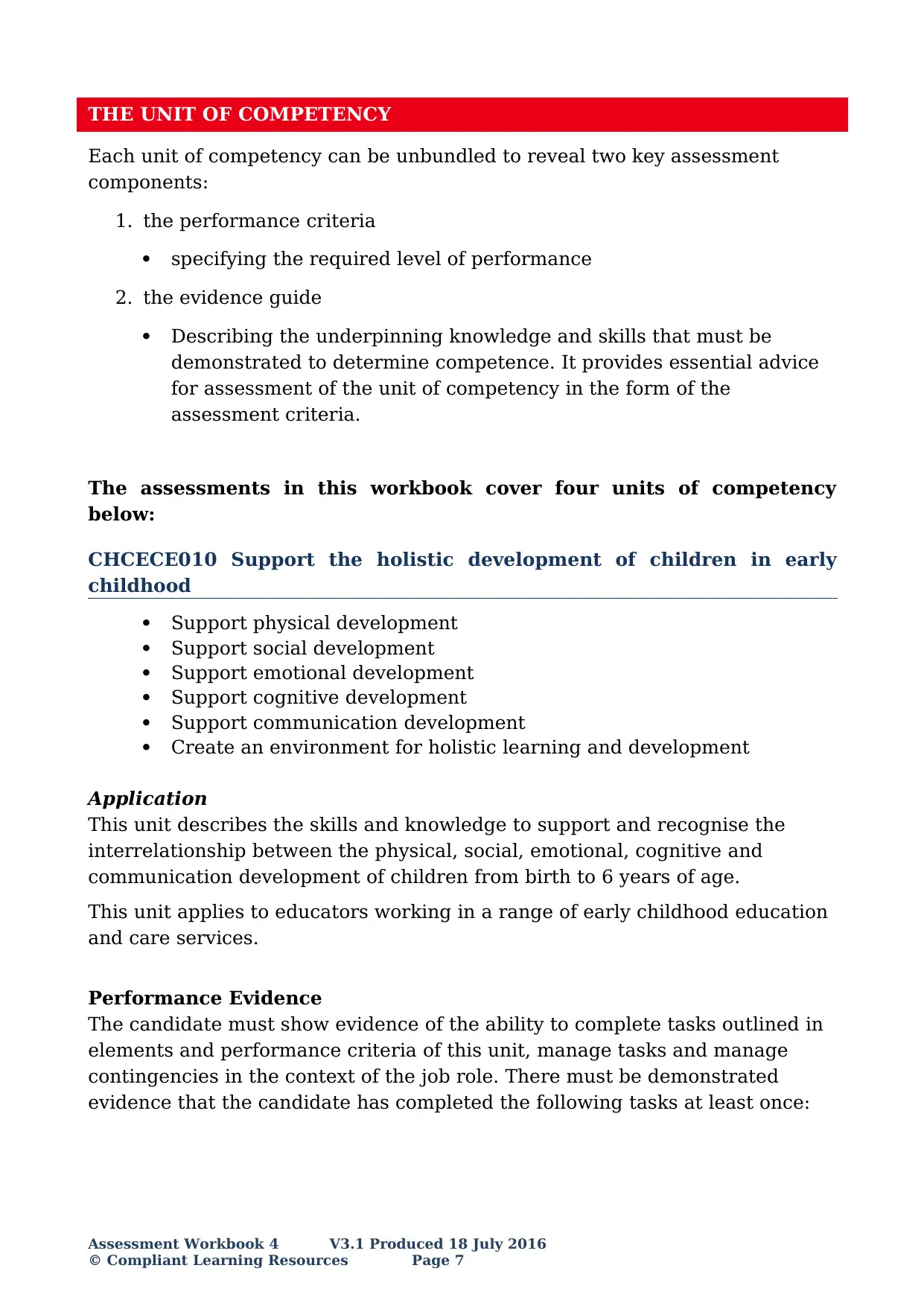
THE UNIT OF COMPETENCY
Each unit of competency can be unbundled to reveal two key assessment
components:
1. the performance criteria
specifying the required level of performance
2. the evidence guide
Describing the underpinning knowledge and skills that must be
demonstrated to determine competence. It provides essential advice
for assessment of the unit of competency in the form of the
assessment criteria.
The assessments in this workbook cover four units of competency
below:
CHCECE010 Support the holistic development of children in early
childhood
Support physical development
Support social development
Support emotional development
Support cognitive development
Support communication development
Create an environment for holistic learning and development
Application
This unit describes the skills and knowledge to support and recognise the
interrelationship between the physical, social, emotional, cognitive and
communication development of children from birth to 6 years of age.
This unit applies to educators working in a range of early childhood education
and care services.
Performance Evidence
The candidate must show evidence of the ability to complete tasks outlined in
elements and performance criteria of this unit, manage tasks and manage
contingencies in the context of the job role. There must be demonstrated
evidence that the candidate has completed the following tasks at least once:
Assessment Workbook 4 V3.1 Produced 18 July 2016
© Compliant Learning Resources Page 7
Each unit of competency can be unbundled to reveal two key assessment
components:
1. the performance criteria
specifying the required level of performance
2. the evidence guide
Describing the underpinning knowledge and skills that must be
demonstrated to determine competence. It provides essential advice
for assessment of the unit of competency in the form of the
assessment criteria.
The assessments in this workbook cover four units of competency
below:
CHCECE010 Support the holistic development of children in early
childhood
Support physical development
Support social development
Support emotional development
Support cognitive development
Support communication development
Create an environment for holistic learning and development
Application
This unit describes the skills and knowledge to support and recognise the
interrelationship between the physical, social, emotional, cognitive and
communication development of children from birth to 6 years of age.
This unit applies to educators working in a range of early childhood education
and care services.
Performance Evidence
The candidate must show evidence of the ability to complete tasks outlined in
elements and performance criteria of this unit, manage tasks and manage
contingencies in the context of the job role. There must be demonstrated
evidence that the candidate has completed the following tasks at least once:
Assessment Workbook 4 V3.1 Produced 18 July 2016
© Compliant Learning Resources Page 7
Paraphrase This Document
Need a fresh take? Get an instant paraphrase of this document with our AI Paraphraser
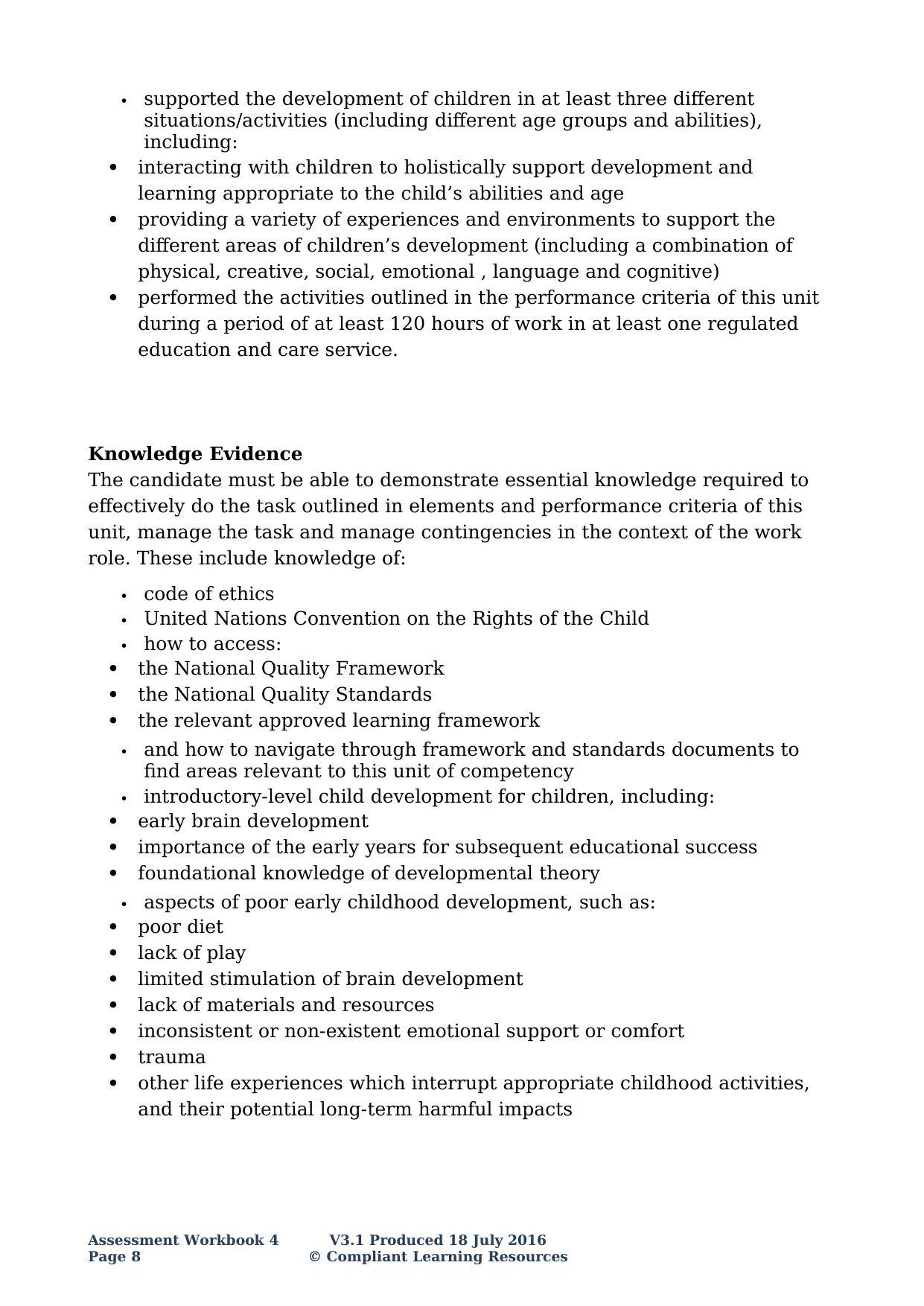
supported the development of children in at least three different
situations/activities (including different age groups and abilities),
including:
interacting with children to holistically support development and
learning appropriate to the child’s abilities and age
providing a variety of experiences and environments to support the
different areas of children’s development (including a combination of
physical, creative, social, emotional , language and cognitive)
performed the activities outlined in the performance criteria of this unit
during a period of at least 120 hours of work in at least one regulated
education and care service.
Knowledge Evidence
The candidate must be able to demonstrate essential knowledge required to
effectively do the task outlined in elements and performance criteria of this
unit, manage the task and manage contingencies in the context of the work
role. These include knowledge of:
code of ethics
United Nations Convention on the Rights of the Child
how to access:
the National Quality Framework
the National Quality Standards
the relevant approved learning framework
and how to navigate through framework and standards documents to
find areas relevant to this unit of competency
introductory-level child development for children, including:
early brain development
importance of the early years for subsequent educational success
foundational knowledge of developmental theory
aspects of poor early childhood development, such as:
poor diet
lack of play
limited stimulation of brain development
lack of materials and resources
inconsistent or non-existent emotional support or comfort
trauma
other life experiences which interrupt appropriate childhood activities,
and their potential long-term harmful impacts
Assessment Workbook 4 V3.1 Produced 18 July 2016
Page 8 © Compliant Learning Resources
situations/activities (including different age groups and abilities),
including:
interacting with children to holistically support development and
learning appropriate to the child’s abilities and age
providing a variety of experiences and environments to support the
different areas of children’s development (including a combination of
physical, creative, social, emotional , language and cognitive)
performed the activities outlined in the performance criteria of this unit
during a period of at least 120 hours of work in at least one regulated
education and care service.
Knowledge Evidence
The candidate must be able to demonstrate essential knowledge required to
effectively do the task outlined in elements and performance criteria of this
unit, manage the task and manage contingencies in the context of the work
role. These include knowledge of:
code of ethics
United Nations Convention on the Rights of the Child
how to access:
the National Quality Framework
the National Quality Standards
the relevant approved learning framework
and how to navigate through framework and standards documents to
find areas relevant to this unit of competency
introductory-level child development for children, including:
early brain development
importance of the early years for subsequent educational success
foundational knowledge of developmental theory
aspects of poor early childhood development, such as:
poor diet
lack of play
limited stimulation of brain development
lack of materials and resources
inconsistent or non-existent emotional support or comfort
trauma
other life experiences which interrupt appropriate childhood activities,
and their potential long-term harmful impacts
Assessment Workbook 4 V3.1 Produced 18 July 2016
Page 8 © Compliant Learning Resources
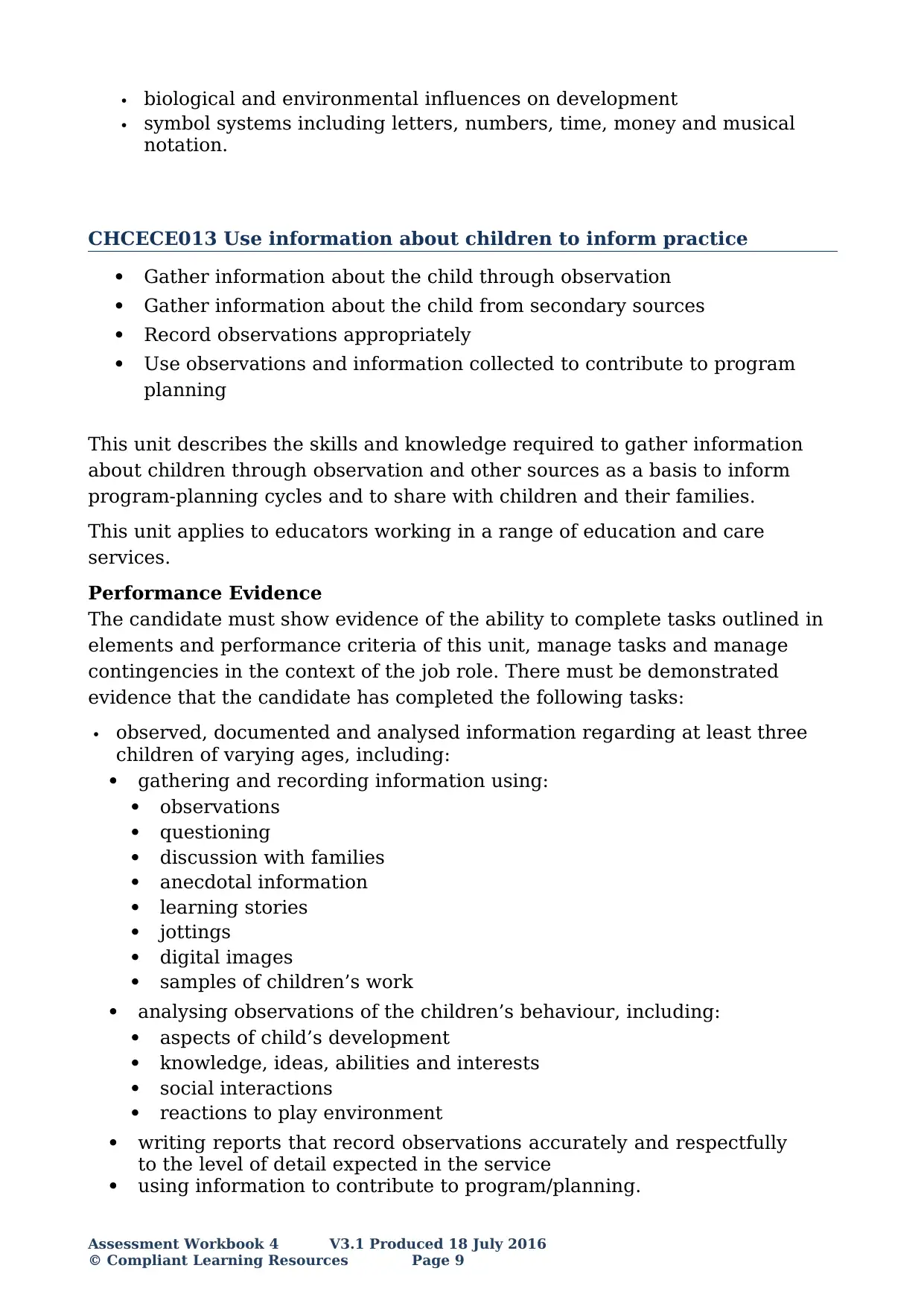
biological and environmental influences on development
symbol systems including letters, numbers, time, money and musical
notation.
CHCECE013 Use information about children to inform practice
Gather information about the child through observation
Gather information about the child from secondary sources
Record observations appropriately
Use observations and information collected to contribute to program
planning
This unit describes the skills and knowledge required to gather information
about children through observation and other sources as a basis to inform
program-planning cycles and to share with children and their families.
This unit applies to educators working in a range of education and care
services.
Performance Evidence
The candidate must show evidence of the ability to complete tasks outlined in
elements and performance criteria of this unit, manage tasks and manage
contingencies in the context of the job role. There must be demonstrated
evidence that the candidate has completed the following tasks:
observed, documented and analysed information regarding at least three
children of varying ages, including:
gathering and recording information using:
observations
questioning
discussion with families
anecdotal information
learning stories
jottings
digital images
samples of children’s work
analysing observations of the children’s behaviour, including:
aspects of child’s development
knowledge, ideas, abilities and interests
social interactions
reactions to play environment
writing reports that record observations accurately and respectfully
to the level of detail expected in the service
using information to contribute to program/planning.
Assessment Workbook 4 V3.1 Produced 18 July 2016
© Compliant Learning Resources Page 9
symbol systems including letters, numbers, time, money and musical
notation.
CHCECE013 Use information about children to inform practice
Gather information about the child through observation
Gather information about the child from secondary sources
Record observations appropriately
Use observations and information collected to contribute to program
planning
This unit describes the skills and knowledge required to gather information
about children through observation and other sources as a basis to inform
program-planning cycles and to share with children and their families.
This unit applies to educators working in a range of education and care
services.
Performance Evidence
The candidate must show evidence of the ability to complete tasks outlined in
elements and performance criteria of this unit, manage tasks and manage
contingencies in the context of the job role. There must be demonstrated
evidence that the candidate has completed the following tasks:
observed, documented and analysed information regarding at least three
children of varying ages, including:
gathering and recording information using:
observations
questioning
discussion with families
anecdotal information
learning stories
jottings
digital images
samples of children’s work
analysing observations of the children’s behaviour, including:
aspects of child’s development
knowledge, ideas, abilities and interests
social interactions
reactions to play environment
writing reports that record observations accurately and respectfully
to the level of detail expected in the service
using information to contribute to program/planning.
Assessment Workbook 4 V3.1 Produced 18 July 2016
© Compliant Learning Resources Page 9
⊘ This is a preview!⊘
Do you want full access?
Subscribe today to unlock all pages.

Trusted by 1+ million students worldwide
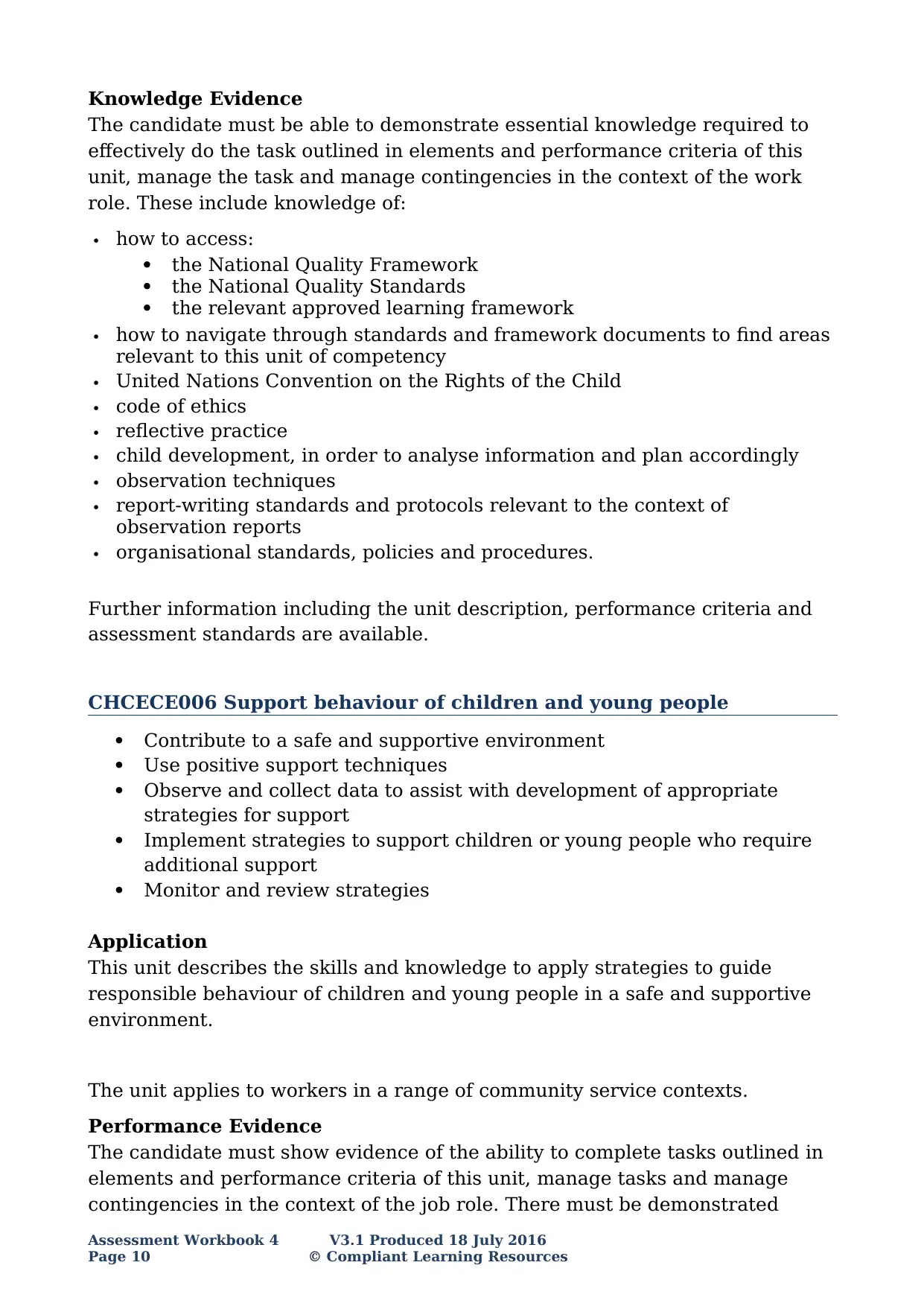
Knowledge Evidence
The candidate must be able to demonstrate essential knowledge required to
effectively do the task outlined in elements and performance criteria of this
unit, manage the task and manage contingencies in the context of the work
role. These include knowledge of:
how to access:
the National Quality Framework
the National Quality Standards
the relevant approved learning framework
how to navigate through standards and framework documents to find areas
relevant to this unit of competency
United Nations Convention on the Rights of the Child
code of ethics
reflective practice
child development, in order to analyse information and plan accordingly
observation techniques
report-writing standards and protocols relevant to the context of
observation reports
organisational standards, policies and procedures.
Further information including the unit description, performance criteria and
assessment standards are available.
CHCECE006 Support behaviour of children and young people
Contribute to a safe and supportive environment
Use positive support techniques
Observe and collect data to assist with development of appropriate
strategies for support
Implement strategies to support children or young people who require
additional support
Monitor and review strategies
Application
This unit describes the skills and knowledge to apply strategies to guide
responsible behaviour of children and young people in a safe and supportive
environment.
The unit applies to workers in a range of community service contexts.
Performance Evidence
The candidate must show evidence of the ability to complete tasks outlined in
elements and performance criteria of this unit, manage tasks and manage
contingencies in the context of the job role. There must be demonstrated
Assessment Workbook 4 V3.1 Produced 18 July 2016
Page 10 © Compliant Learning Resources
The candidate must be able to demonstrate essential knowledge required to
effectively do the task outlined in elements and performance criteria of this
unit, manage the task and manage contingencies in the context of the work
role. These include knowledge of:
how to access:
the National Quality Framework
the National Quality Standards
the relevant approved learning framework
how to navigate through standards and framework documents to find areas
relevant to this unit of competency
United Nations Convention on the Rights of the Child
code of ethics
reflective practice
child development, in order to analyse information and plan accordingly
observation techniques
report-writing standards and protocols relevant to the context of
observation reports
organisational standards, policies and procedures.
Further information including the unit description, performance criteria and
assessment standards are available.
CHCECE006 Support behaviour of children and young people
Contribute to a safe and supportive environment
Use positive support techniques
Observe and collect data to assist with development of appropriate
strategies for support
Implement strategies to support children or young people who require
additional support
Monitor and review strategies
Application
This unit describes the skills and knowledge to apply strategies to guide
responsible behaviour of children and young people in a safe and supportive
environment.
The unit applies to workers in a range of community service contexts.
Performance Evidence
The candidate must show evidence of the ability to complete tasks outlined in
elements and performance criteria of this unit, manage tasks and manage
contingencies in the context of the job role. There must be demonstrated
Assessment Workbook 4 V3.1 Produced 18 July 2016
Page 10 © Compliant Learning Resources
Paraphrase This Document
Need a fresh take? Get an instant paraphrase of this document with our AI Paraphraser
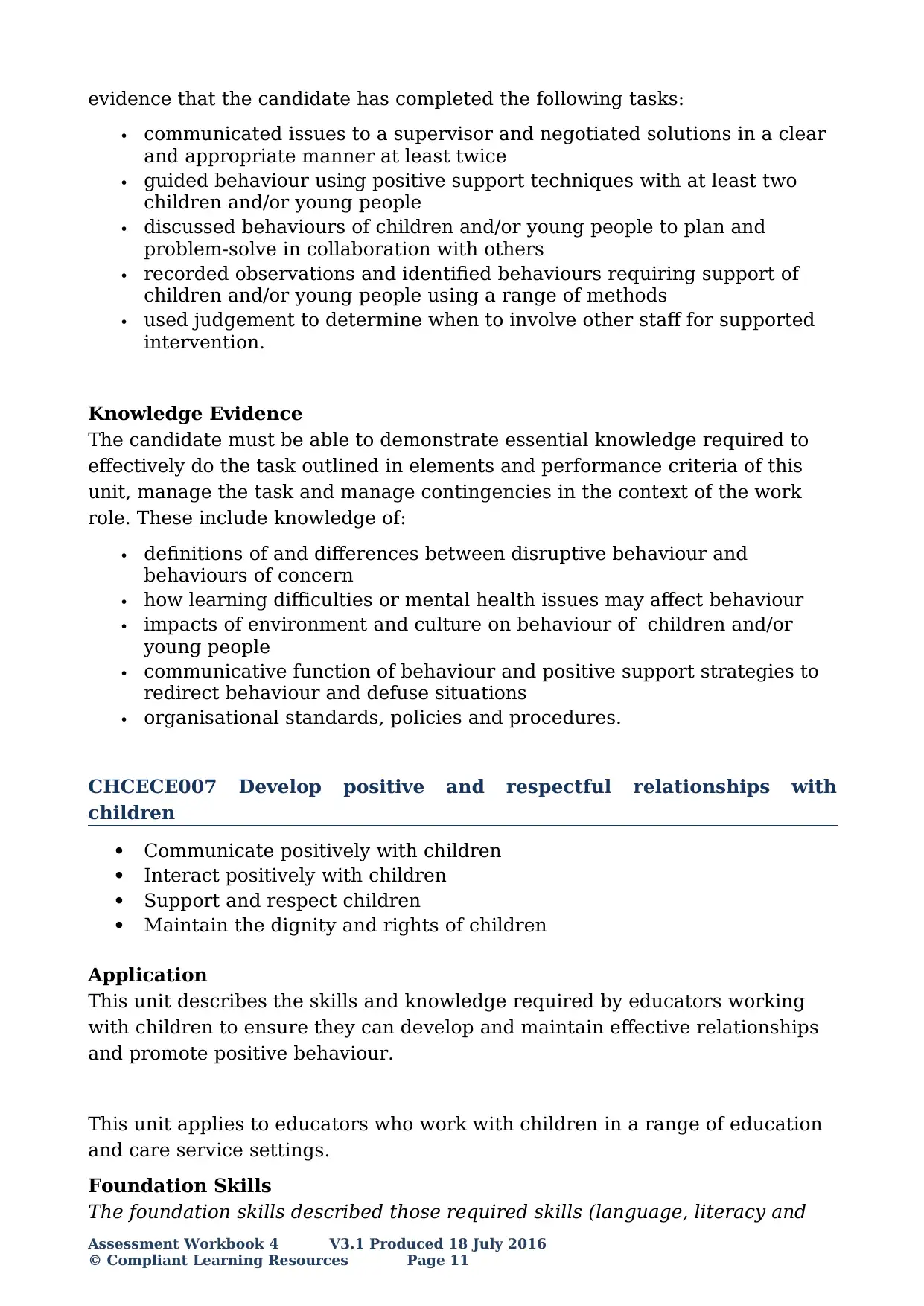
evidence that the candidate has completed the following tasks:
communicated issues to a supervisor and negotiated solutions in a clear
and appropriate manner at least twice
guided behaviour using positive support techniques with at least two
children and/or young people
discussed behaviours of children and/or young people to plan and
problem-solve in collaboration with others
recorded observations and identified behaviours requiring support of
children and/or young people using a range of methods
used judgement to determine when to involve other staff for supported
intervention.
Knowledge Evidence
The candidate must be able to demonstrate essential knowledge required to
effectively do the task outlined in elements and performance criteria of this
unit, manage the task and manage contingencies in the context of the work
role. These include knowledge of:
definitions of and differences between disruptive behaviour and
behaviours of concern
how learning difficulties or mental health issues may affect behaviour
impacts of environment and culture on behaviour of children and/or
young people
communicative function of behaviour and positive support strategies to
redirect behaviour and defuse situations
organisational standards, policies and procedures.
CHCECE007 Develop positive and respectful relationships with
children
Communicate positively with children
Interact positively with children
Support and respect children
Maintain the dignity and rights of children
Application
This unit describes the skills and knowledge required by educators working
with children to ensure they can develop and maintain effective relationships
and promote positive behaviour.
This unit applies to educators who work with children in a range of education
and care service settings.
Foundation Skills
The foundation skills described those required skills (language, literacy and
Assessment Workbook 4 V3.1 Produced 18 July 2016
© Compliant Learning Resources Page 11
communicated issues to a supervisor and negotiated solutions in a clear
and appropriate manner at least twice
guided behaviour using positive support techniques with at least two
children and/or young people
discussed behaviours of children and/or young people to plan and
problem-solve in collaboration with others
recorded observations and identified behaviours requiring support of
children and/or young people using a range of methods
used judgement to determine when to involve other staff for supported
intervention.
Knowledge Evidence
The candidate must be able to demonstrate essential knowledge required to
effectively do the task outlined in elements and performance criteria of this
unit, manage the task and manage contingencies in the context of the work
role. These include knowledge of:
definitions of and differences between disruptive behaviour and
behaviours of concern
how learning difficulties or mental health issues may affect behaviour
impacts of environment and culture on behaviour of children and/or
young people
communicative function of behaviour and positive support strategies to
redirect behaviour and defuse situations
organisational standards, policies and procedures.
CHCECE007 Develop positive and respectful relationships with
children
Communicate positively with children
Interact positively with children
Support and respect children
Maintain the dignity and rights of children
Application
This unit describes the skills and knowledge required by educators working
with children to ensure they can develop and maintain effective relationships
and promote positive behaviour.
This unit applies to educators who work with children in a range of education
and care service settings.
Foundation Skills
The foundation skills described those required skills (language, literacy and
Assessment Workbook 4 V3.1 Produced 18 July 2016
© Compliant Learning Resources Page 11
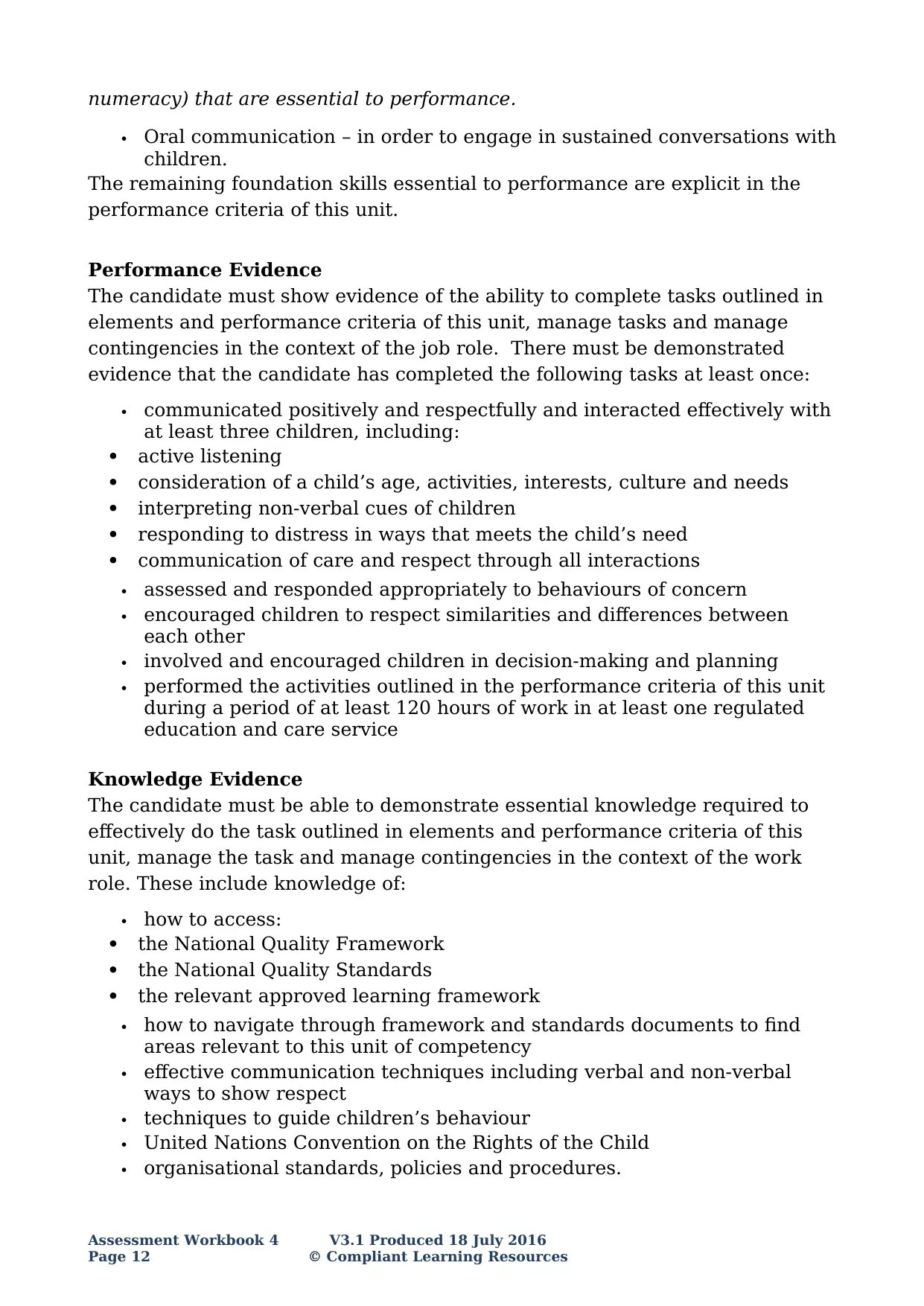
numeracy) that are essential to performance.
Oral communication – in order to engage in sustained conversations with
children.
The remaining foundation skills essential to performance are explicit in the
performance criteria of this unit.
Performance Evidence
The candidate must show evidence of the ability to complete tasks outlined in
elements and performance criteria of this unit, manage tasks and manage
contingencies in the context of the job role. There must be demonstrated
evidence that the candidate has completed the following tasks at least once:
communicated positively and respectfully and interacted effectively with
at least three children, including:
active listening
consideration of a child’s age, activities, interests, culture and needs
interpreting non-verbal cues of children
responding to distress in ways that meets the child’s need
communication of care and respect through all interactions
assessed and responded appropriately to behaviours of concern
encouraged children to respect similarities and differences between
each other
involved and encouraged children in decision-making and planning
performed the activities outlined in the performance criteria of this unit
during a period of at least 120 hours of work in at least one regulated
education and care service
Knowledge Evidence
The candidate must be able to demonstrate essential knowledge required to
effectively do the task outlined in elements and performance criteria of this
unit, manage the task and manage contingencies in the context of the work
role. These include knowledge of:
how to access:
the National Quality Framework
the National Quality Standards
the relevant approved learning framework
how to navigate through framework and standards documents to find
areas relevant to this unit of competency
effective communication techniques including verbal and non-verbal
ways to show respect
techniques to guide children’s behaviour
United Nations Convention on the Rights of the Child
organisational standards, policies and procedures.
Assessment Workbook 4 V3.1 Produced 18 July 2016
Page 12 © Compliant Learning Resources
Oral communication – in order to engage in sustained conversations with
children.
The remaining foundation skills essential to performance are explicit in the
performance criteria of this unit.
Performance Evidence
The candidate must show evidence of the ability to complete tasks outlined in
elements and performance criteria of this unit, manage tasks and manage
contingencies in the context of the job role. There must be demonstrated
evidence that the candidate has completed the following tasks at least once:
communicated positively and respectfully and interacted effectively with
at least three children, including:
active listening
consideration of a child’s age, activities, interests, culture and needs
interpreting non-verbal cues of children
responding to distress in ways that meets the child’s need
communication of care and respect through all interactions
assessed and responded appropriately to behaviours of concern
encouraged children to respect similarities and differences between
each other
involved and encouraged children in decision-making and planning
performed the activities outlined in the performance criteria of this unit
during a period of at least 120 hours of work in at least one regulated
education and care service
Knowledge Evidence
The candidate must be able to demonstrate essential knowledge required to
effectively do the task outlined in elements and performance criteria of this
unit, manage the task and manage contingencies in the context of the work
role. These include knowledge of:
how to access:
the National Quality Framework
the National Quality Standards
the relevant approved learning framework
how to navigate through framework and standards documents to find
areas relevant to this unit of competency
effective communication techniques including verbal and non-verbal
ways to show respect
techniques to guide children’s behaviour
United Nations Convention on the Rights of the Child
organisational standards, policies and procedures.
Assessment Workbook 4 V3.1 Produced 18 July 2016
Page 12 © Compliant Learning Resources
⊘ This is a preview!⊘
Do you want full access?
Subscribe today to unlock all pages.

Trusted by 1+ million students worldwide
1 out of 69
Related Documents
Your All-in-One AI-Powered Toolkit for Academic Success.
+13062052269
info@desklib.com
Available 24*7 on WhatsApp / Email
![[object Object]](/_next/static/media/star-bottom.7253800d.svg)
Unlock your academic potential
Copyright © 2020–2025 A2Z Services. All Rights Reserved. Developed and managed by ZUCOL.





